March 2, 2011 – 6:42 AM MST (1342 UT) a Juno Target Missile was launched from Fort Wingate, New Mexico toward the White Sands Missile Range.
Video of Juno Target Missile Launch – March 2, 2011
Click here to go to YouTube and view in HD.
I got up early this morning for a chance to view a morning twilight launch. My first view of a twilight launch was the evening launch of a Minotaur DARPAS rocket in 2005. It was a stunning sight to behold, and I didn’t want to pass this opportunity up…even if it meant rolling out of bed at 5:30 to start the day.
One of my mistakes in 2005 was not being ready when the rocket contrail first appeared. The camera battery was dead and the lens unfocused. By the time I got the battery replaced and the camera only passingly focused, I had missed snagging better images. Not this time…but it was close. The SLR and video camera were on tripods, focused and exposures set with five minutes to spare! (The sketch pad was sitting there too, but that’s another story for later.)
The launch window was from 6:30 – 7:30 AM MST (1330-1430 UT). I knew it would appear due east of Flagstaff (from Fort Wingate, NM) and head southward (toward White Sands Missile Range). What I didn’t know was how much altitude it would gain. It wasn’t going to be an orbital vehicle like the Minotaur launch, but I was also going to be much closer to the trajectory. As far as I knew, it was possible the visible trail could have been hidden by trees.
After 10 minutes of waiting, as the sky got progressively brighter, I had to wonder whether it had already launched but was too low to see, or too faint, or if the launch had been scrubbed altogether. Just as I was deciding how long to wait before twilight got too bright, I noticed a white, vertical contrail rising just to the left of a nearby tree. The trail disappeared behind a broad stroke of pink cirrus. Following its path upward, I saw nothing else along the anticipated path. I started shooting the gradually zig-zagging boost trail, wondering if that would be the extent of the display.
About a minute later, a brilliant swoop suddenly appeared high above the trees. After arcing southward for several seconds, the missile appeared to exit the lower atmosphere, and the exhaust started to do that strange, blossoming dance that seems to happen when it’s not constrained by dense air. Shortly afterward, at burnout, its progress disappeared and the remaining trail of white mist slowly twisted up amid a canvas of blazing orange and pink cirrus.
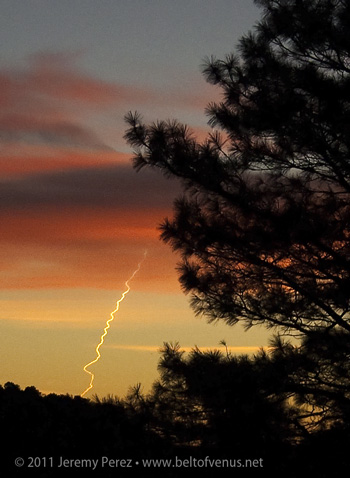
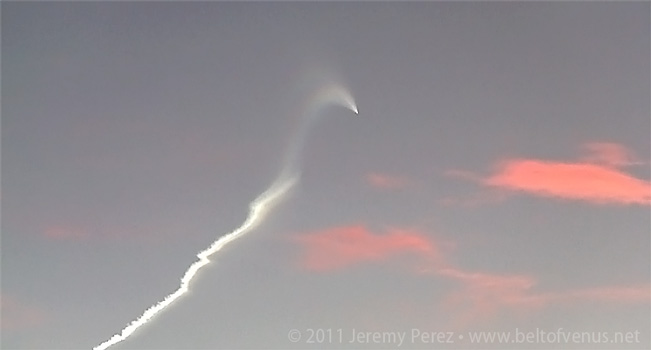
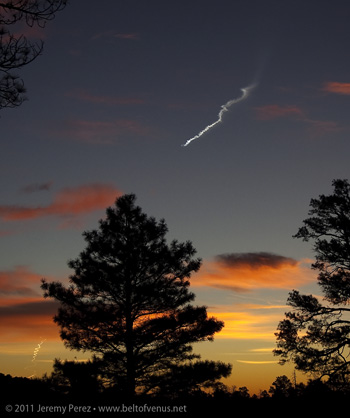
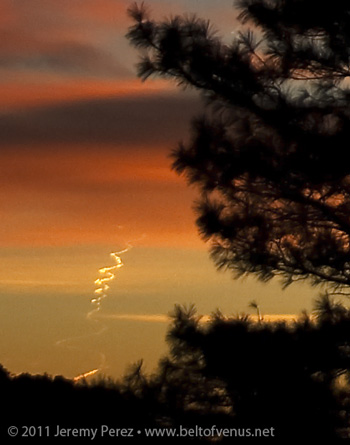
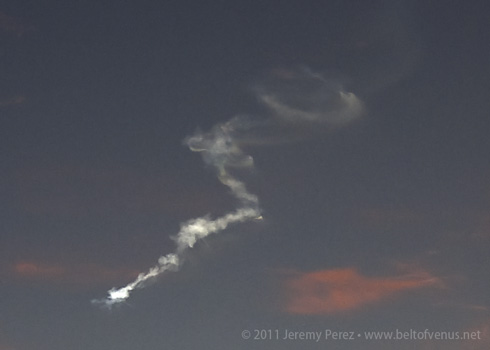
Great video and story! I saw the missile as I was skiing into Buffalo Park. I thought it must have been a missile and got a photo just after the crazy spinning. I’m glad that I found your excellent information on it. Cheers, Ed.
Thanks for the comment, Ed! It had to be great to see one of these go up when you weren’t expecting it.
I saw this as a pilot of a comercial aircraft.. First rocket launch I ever saw and was really neat!
Great video and photos Jeremy!
These are my captures.
http://www.youtube.com/watch?v=R7yIPoumz24&t=18s
http://www.flickr.com/photos/tradica/sets/72157626058674481/
Jeff, that must have been a fascinating perspective!
Robert, thanks for sharing the photos and video–great color! Looks like you had a good horizon and cooperative clouds to catch the initial booster contrail. A couple folks I’ve heard from didn’t see that portion from the Phoenix area.
Thanks both for your comments!
Thank you so much for your detail to attention & great photography. I live about 65-70 miles north of Vandenberg AFB (as the crow flies) in Morro Bay, Cal., and see many of the polar orbital launches, but the air is much thicker here at sea level. Keep up the good work.
Regards,
Andy
The Beach Goat
Thanks for the comment, Andy! That has to be a great location to view launches…as long as the marine layer is cooperating.
Jeremy